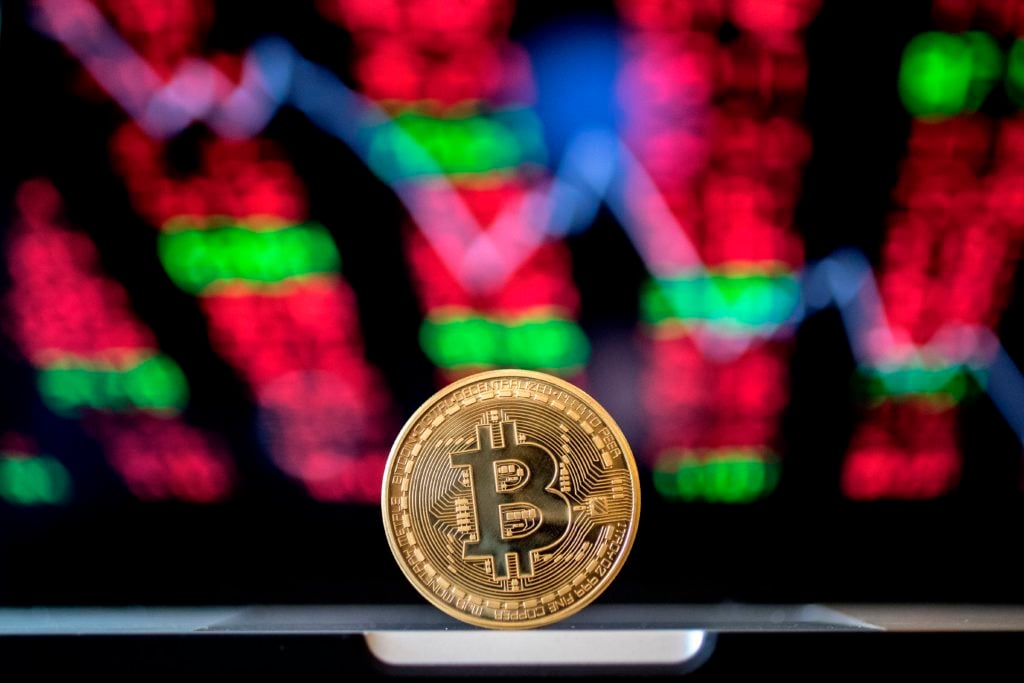This piece is the third in a three-part series that explores the potential art-world impact of cryptocurrency. It proceeds as if the reader is already familiar with the core concepts and related terminology covered in Part I and Part II. If cryptocurrencies and blockchain technology are new to you, we highly recommend starting from the beginning.
To hear any true believer tell it, blockchain technology will quite literally change everything about how we as a society do business, and the art industry will be transformed as a part of this wholesale reformation. The questions are only how and when it will do so.
Timing is the hobgoblin of every revolution. The right idea pursued at the wrong moment tends to be no more effective than the wrong idea at, well, any moment. To have the most fruitful discussion about the blockchain’s possible effects on our business of choice, then, let’s burn the calendar and shine the light on the three most promising use cases being pursued today, so that we can evaluate their solutions on the merits.
PROBLEM 1: THE LINGERING MYSTERIES OF PROVENANCE & AUTHENTICITY
Relatively few artworks today offer the air-tight security of a certificate of authenticity backed by an unbroken chain of title. Gaps in the provenance paper trail undermine both sides of the market, with collectors often left to wonder if they’re being presented looted works or outright fakes, and sellers sometimes forced to accept lower offers due to buyers’ hesitance over the uncertainties.

Tracing the provenance of artworks looted during the Nazi era has been a major topic of public discussion: World Jewish Congress president Ronald S. Lauder delivering a speech on the issue of Nazi-era looted art, at the Kunsthaus in Zurich, February 2, 2016. Photo courtesy Michael Buholzer /AFP/Getty Images.
BLOCKCHAIN SOLUTION: DECENTRALIZED TITLE REGISTRY
Most readers know that hundreds of databases for provenance information already exist in the industry. Every responsible gallery, auction house, institution, and major collector runs software to systemize their inventory and its history. So why would a blockchain-powered update be transformative?
Rather than siloing analog provenance data with individual players, blockchain technology provides an opportunity to build a publicly searchable, fully collaborative, tamper-proof title registry for artworks. This database would securely track more than just ownership changes. It would also verify and aggregate every other event that affects an artwork’s value, such as professional appraisals, conservation treatments, inclusion in museum or gallery exhibitions, and much more.
Just as with cryptocurrencies, the blockchain’s decentralized nature prevents provenance data from being either falsified or lost. If a bad actor tries to manipulate the ledger on one computer, the rest of the network hosting and verifying the blockchain would detect the deviance. And since the ledger exists in the cloud (i.e. the data is distributed across multiple servers in multiple places), it can’t be lost or accidentally destroyed by a single record-holder. This makes a proper blockchain title registry more trustworthy and more durable than any centralized database tracking the same information, let alone physical archives or other analog records.
Furthermore, a blockchain provenance ledger could also be both far more robust than and, paradoxically, just as private as traditional alternatives. In an optimal structure, anyone who knew anything of value about any registered artwork could help fill out the database. At the same time, the information flow could also be designed so that the identities of participating informants remained anonymous to the public—as long as they are known and approved by the registry’s creator.
Think of it like a book recommendation: If the end-user trusts the judgment of the go-between, they can be comfortable with the content even without knowing anything about its original source.
The outcome of this process would be two-pronged: a vast collection of blockchains, each one verifying, time-stamping, and digitally preserving every provenance event in the life of an artwork; and a publicly searchable database containing the data from those same blockchains, anonymized to protect privacy and incentivize participation within a frustratingly secretive industry.
In theory, then, a blockchain title registry would dramatically amplify the amount of confidence in the art market. Since the provenance for any registered piece would be thoroughly vetted by a neutral third-party and legible to anyone interested, this innovation should lead to more buyers willing to pay more money for the added layer of security.
As Nanne Dekking, co-founder of blockchain title-registry startup Artory, explained to artnet News, “The product is data integrity.” With Artory and other players, including Codex and Verisart, actively building out decentralized provenance networks, developers seem convinced that the product could be lucrative.
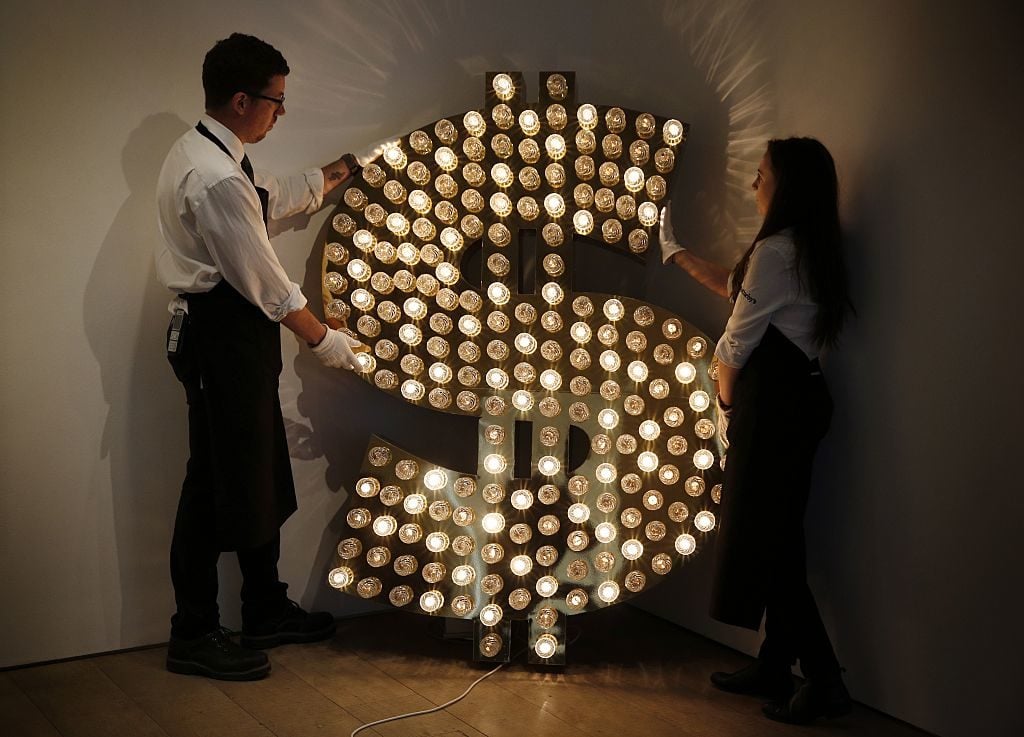
Sotheby’s employees pose with Tim Noble and Sue Webster’s $. Image courtesy Adrian Dennis//AFP/Getty Images.
HOWEVER…
There are still significant challenges ahead of any blockchain title registry.
First, collecting and digitizing thousands of years worth of analog data on existing artworks is a gargantuan task, even if everyone in the market desperately wants to participate. If many people resist, though, the task could quickly slide into the realm of the impossible. So this solution may be best for newly created works, particularly those born digital.
Second, even if an artwork boasts a flawless provenance on the blockchain, it needs an equally secure mechanism for keeping the blockchain connected to the artwork itself in the physical world. Otherwise, a fraudster could detach one from the other and “verify” a fake by tying the forgery to a legitimate (block)chain of title.
Third, the viability of the project depends on buyers demonstrating that they are willing to pay a premium for data integrity. If the industry produces a robust title registry for artworks, but existing collectors refuse to pay more for the pieces it tracks than those it doesn’t—and/or if the database’s existence fails to motivate a significant number of new buyers to enter the market—then the value proposition of a blockchain title registry withers and dies.
PROBLEM 2: THE WEIGHT OF THE TRADITIONAL FINANCE SYSTEM
No matter how much old-fashioned money you have, a slew of transactional problems still clings to it like a musty thrift-store scent to a great vintage dress. These annoyances mostly take the form of fees and regulations. Banks generally charge their customers for everything from sending wire transfers to converting between currencies, while some federal governments apply internal restrictions to their own citizens (see: China) and/or provoke external sanctions from abroad (see: Russia). All of the above discourages, or outright precludes, some participation in the art market.
“When I came out as a gallery that accepts cryptocurrencies, that move was to open borders,” London gallerist Eleesa Dadiani, who has heavily promoted her own use of Bitcoin, told the Cultural Frontline podcast, boasting about her ability to circumvent centralized law. “That way we struck a dialogue with Russia, with China, with many countries that find internal money transport difficult due to internal sanctions or any other thing that restricts the ebb and flow of money.”
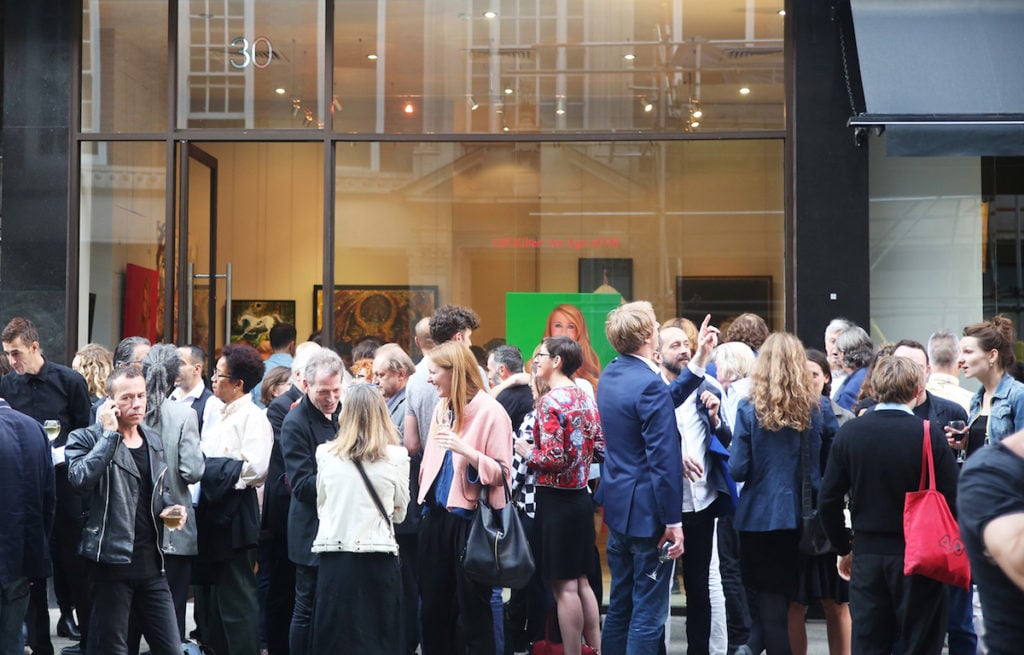
An IRL opening at Dadiani Fine Art in London. Image courtesy Dadiani Fine Art.
BLOCKCHAIN SOLUTION: TOKENIZED PAYMENT
Cryptocurrencies bob and weave around these obstacles through decentralization. An art seller merely has to set up and maintain a relatively simple digital infrastructure, called a cryptocurrency wallet, to accept blockchain-based payments. Without thrusting your entire head into the jargon swamp, cryptocurrency wallets can be either software or hardware that connects users to the network(s) of computers maintaining the ledger for various cryptocurrencies.
It’s popular to analogize these wallets to virtual bank vaults or safety deposit boxes. Instead of old-school combination locks, users access them through a password known as a private key. To facilitate transactions, wallet owners hand out a public key—essentially an account number—to clients who want to pay them in cryptocurrency. From there, the rest of the transaction plays out in broadly the same way as a wire or ACH payment, with the blockchain ledger updating the new token exchange based on matching keys.
However, the crucial difference from these traditional payment types is that the exchange takes place entirely between the buyer and seller, i.e. completely free of intermediaries and centralized oversight. There are no banks to slow the exchange and charge exorbitant fees for services, like the standard three percent cost of currency conversion. (Cryptocurrency transactions sometimes still incur fees, but most can be executed for a few cents to a few dollars, and many others at no cost.) There are no government regulators to prevent the funds from changing hands, either. So transactions can happen faster and cheaper than through legacy channels, and the market benefits.
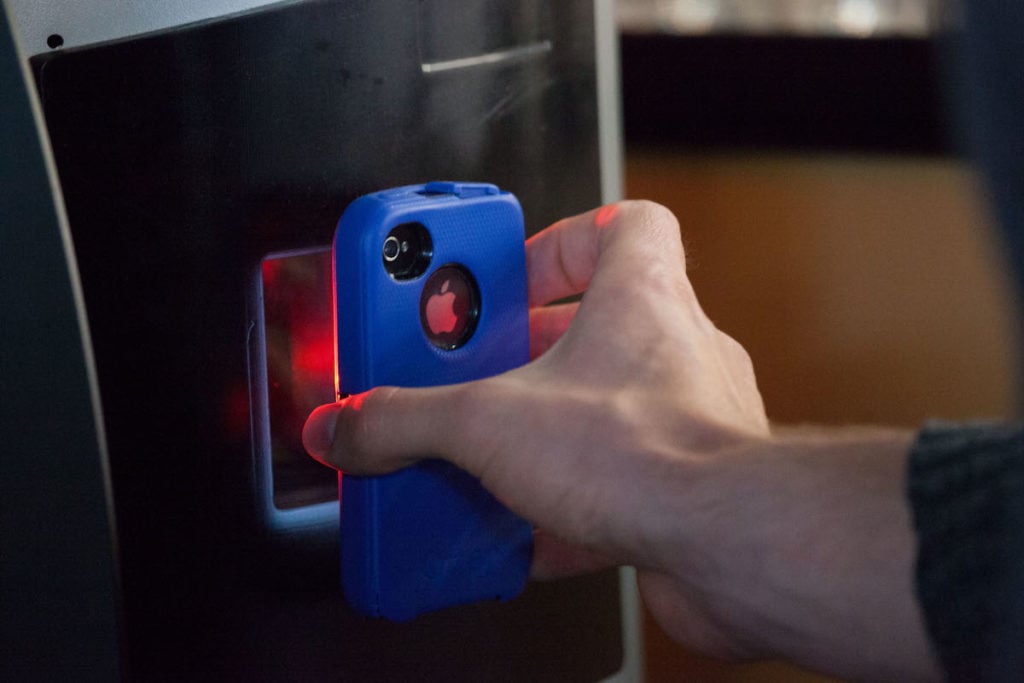
A user scans a QR code on their smart phone, allowing bitcoins to be transferred into their digital wallet, while using the world’s first bitcoin ATM on October 29, 2013 at Waves Coffee House in Vancouver, British Columbia. Photo courtesy David Ryder/Getty Images.
HOWEVER…
Two big questions linger over tokenized payment: buyers’ scale of need, and sellers’ willingness to adopt the technology. Codex CEO Mark Lurie told artnet News that there are “innumerable new millionaires and billionaires” with cryptocurrency holdings anxious to enter the art market by “paying the ways they’re used to paying.” That’s the same sentiment that Dadiani Fine Art has picked up on, and generated plenty of media attention as a result.
But for art sellers on the outside of the crypto community, the size and hunger of this underserved market remains mysterious. The only way to learn more is to take a leap of faith into blockchain-based payments. And the continued volatility of cryptocurrencies makes that leap seem all the scarier to many, if not most, traditional dealers.

In the apparent absence of a contract defining the terms of sale, Alec Baldwin’s attorneys had to rely on email correspondence and other evidence in a 2016 civil suit against dealer Mary Boone, who Baldwin alleged sold him a new Ross Bleckner painting posing as an earlier work he had been chasing for years. Photo by Theo Wargo/Getty Images.
PROBLEM 3: THE BURDEN OF TRADITIONAL CONTRACTS
Even in fields that heavily rely on formal agreements, writing and executing contracts is a tedious, expensive process—one that often requires spending days or weeks working to hone the language with a counterparty, all while paying a knee-buckling hourly rate to an attorney. Worse, if the counterparty later violates the finalized contract, the only way to enforce the terms (short of vigilante justice, anyway) is to spend many more hours and thousands more dollars back inside the legal system.
The art world complicates matters even further, as the industry’s longstanding aversion to contracts means that a potential deal can disintegrate if one side even proposes adopting a formal agreement.
BLOCKCHAIN SOLUTION: SMART CONTRACTS
Smart contracts are somewhat abstract, so an analogy is helpful. Near the end of Stanley Kubrick’s Cold War black comedy Dr. Strangelove, the motley crew in the American war room learns that the Soviet Union has secretly assembled a nuclear deterrent called a Doomsday Machine. If an aggressor were to try hitting the USSR with a pre-emptive nuclear strike, the Doomsday Machine would nuke right back, even if the entire human military apparatus had already been vaporized. Strangelove explains that the device is “designed to trigger itself automatically… under a specific and clearly defined set of circumstances… programmed into a gigantic complex of computers.”
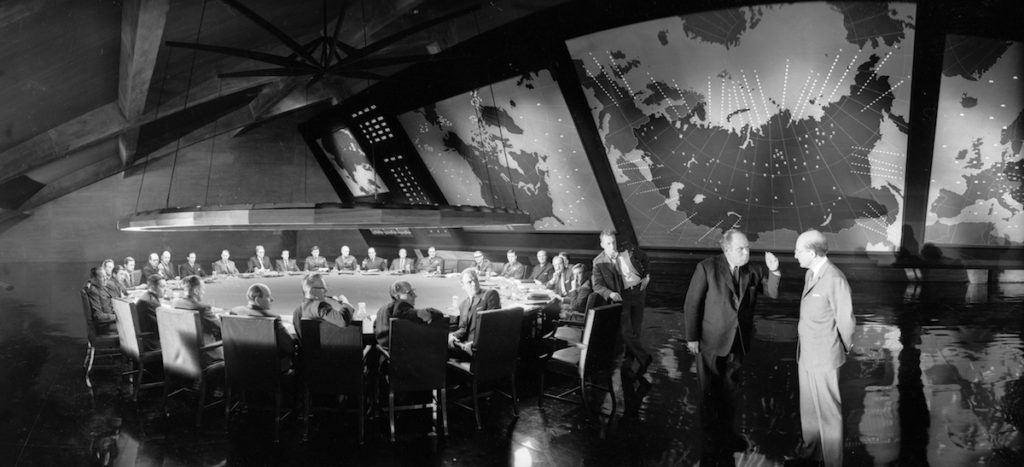
14th March 1963: Filming on the set of Dr Strangelove or: How I Learned to Stop Worrying and Love the Bomb, directed by Stanley Kubrick. Photo courtesy Express/Express/Getty Images.
A few decades before the blockchain’s emergence, the Doomsday Machine basically ran on a smart contract: a digital agreement between parties where the terms—what is to be done, when it is to be done, and how—are all hard-coded in advance. After reading and executing the agreement, individuals can no longer disrupt it. Nor is an intermediary (see: the legal/judicial system) needed to monitor fulfillment, making the smart contract more secure, more efficient, and vastly cheaper than a traditional one.
Broadly speaking, smart contracts operate by the same underlying mechanism as cryptocurrencies (AKA “smart money”). Today, their main platform is the blockchain network Ethereum. Although Ethereum hosts its own cryptocurrency, called Ether, its architects designed the distributed ledger to be open-source—and capable of tracking more than just debt. This means Ethereum users can write code to automatically govern anything on the blockchain that is definable in simple contract terms, such as transfers of digital goods or services, as well as trigger events for those transfers.
Smart contracts could have multiple benefits to the art industry. By streamlining the administration and minimizing the costs of implementing legal protections, they could simultaneously increase the professionalization and the fluidity of art sales. Smart contracts could also be written to integrate longed-for (yet still controversial) advancements like artists’ resale royalties, seamlessly.

Founder of Ethereum Vitalik Buterin during TechCrunch Disrupt London 2015. Photo courtesy John Phillips/Getty Images for TechCrunch.
Even more potential uses exist when the lens expands from art sales to art services. For example, Codex’s Biddable app will leverage smart contracts to allow new buyers to do something unprecedented in auction history: register to bid as an anonymous party. Thanks to a “deposit-escrow system” built on the Ethereum network, any interested party with the resources can use cryptocurrency to pay a deposit amount set by a participating auction house for their desired lot. And since that payment is hard-coded to be lost to the bidder (or in the language of Codex’s white paper, “burned”) if they renege on the winning bid, the house can feel comfortable handing over a (virtual) paddle without resorting to the traditional process of first auditing the new bidder’s identity and liquid assets through an invasive, inefficient document review.
HOWEVER…
John Watkinson, co-founder of Larva Labs and blockchain collectible sensation CryptoPunks, told artnet News that a smart contract “only achieves its ideal when you’re dealing with digital assets or pure digital structures. As soon as the real world gets involved… it gets more complicated.”

Examples of CryptoPunks, tradable digital icons based on Etherium. Image courtesy Larva Labs.
Watkinson calls this limitation the “blockchain air gap”: the void that a smart contract, or any other crypto-solution, can never bridge IRL. So a smart contract could brilliantly streamline the marketplace for, say, certain new-media artworks. But if you used one to buy a house, the blockchain would be powerless to help you on move-in day if the home wasn’t in the condition it was promised to be, or if the original owners decided to barricade themselves inside with your money.
Developers and entrepreneurs in this space are well aware of blockchain air gaps, and most are hard at work on minimizing the number and size of those voids.
Whether inside or outside the art industry, though, decentralized technology’s transformative effects will depend on more than just coding skills. They will also depend on how the average citizen reacts to the imperfections impossible to eliminate from the technology. As history tells us, few revolutions hold without winning the hearts and minds of the common people.
